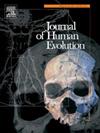The Neanderthal cervical spine revisited
IF 3.1
1区 地球科学
Q1 ANTHROPOLOGY
引用次数: 0
Abstract
Recent studies have challenged the long-held notion that Neanderthals possessed a more stable and less lordotic cervical spine than modern humans. To investigate this hypothesis further, we conducted the first three-dimensional geometric morphometric analysis focused on the Neanderthal cervical spine, examining 43 classic Homo neanderthalensis cervical vertebrae alongside 243 Homo sapiens cervical vertebrae from diverse populations, including the whole cervical spine (C1–C7). The Neanderthal sample comprises specimens from well-known individuals such as La Ferrassie 1, La Chapelle-aux-Saints 1, Kebara 2, Shanidar 2, Regourdou 1, and the Krapina group, ensuring completeness for a detailed analysis. Our results reveal a distinct morphological difference—that is greater in the lower levels—in the Neanderthal cervical spine, including a craniocaudally shorter and mediolaterally wider shape, longer spinous processes, and horizontally oriented articular facets. Contrary to earlier hypotheses, the study challenges the notion of reduced cervical lordosis in Neanderthals, proposing instead a potentially greater lordotic curvature than in modern humans, as evidenced by articulated mean forms and Cobb angle measurements. These findings suggest robust neck musculature adaptations in Neanderthals, potentially reflecting biomechanical responses to support the head and inhibit joint displacement. The study also highlights implications for respiratory biomechanics, with differences in the orientation of transverse processes (attachment site of the scalene muscle) potentially influencing neck muscle length and function, which could affect respiratory capacity in Neanderthals. In summary, our comprehensive examination sheds new light on the morphology and functional implications of the Neanderthal cervical spine, offering valuable insights into the intricate adaptations of Neanderthals and their implications for functional morphology and evolutionary biology.
尼安德特人的颈椎重新审视
最近的研究挑战了长期以来的观念,即尼安德特人比现代人拥有更稳定、更少前凸的颈椎。为了进一步研究这一假设,我们对尼安德特人的颈椎进行了首次三维几何形态分析,研究了43个经典的尼安德特人颈椎和243个来自不同种群的智人颈椎,包括整个颈椎(C1-C7)。尼安德特人样本包括来自知名个体的标本,如La Ferrassie 1、La Chapelle-aux-Saints 1、Kebara 2、Shanidar 2、Regourdou 1和Krapina组,确保了详细分析的完整性。我们的研究结果揭示了尼安德特人颈椎明显的形态差异,这种差异在较低水平上更大,包括颅侧较短和中外侧较宽的形状,较长的棘突和水平方向的关节面。与早期的假设相反,该研究挑战了尼安德特人颈椎前凸程度降低的概念,提出了比现代人更大的颈椎前凸度,这一点可以通过关节平均形式和Cobb角测量来证明。这些发现表明尼安德特人强健的颈部肌肉组织适应性,可能反映了支持头部和抑制关节位移的生物力学反应。该研究还强调了呼吸生物力学的意义,横突(斜角肌的附着部位)方向的差异可能会影响颈部肌肉的长度和功能,这可能会影响尼安德特人的呼吸能力。总之,我们的综合研究揭示了尼安德特人颈椎的形态和功能含义,为尼安德特人复杂的适应性及其对功能形态和进化生物学的影响提供了有价值的见解。
本文章由计算机程序翻译,如有差异,请以英文原文为准。
求助全文
约1分钟内获得全文
求助全文
来源期刊

Journal of Human Evolution
生物-进化生物学
CiteScore
6.30
自引率
15.60%
发文量
104
审稿时长
3 months
期刊介绍:
The Journal of Human Evolution concentrates on publishing the highest quality papers covering all aspects of human evolution. The central focus is aimed jointly at paleoanthropological work, covering human and primate fossils, and at comparative studies of living species, including both morphological and molecular evidence. These include descriptions of new discoveries, interpretative analyses of new and previously described material, and assessments of the phylogeny and paleobiology of primate species. Submissions should address issues and questions of broad interest in paleoanthropology.
 求助内容:
求助内容: 应助结果提醒方式:
应助结果提醒方式:


